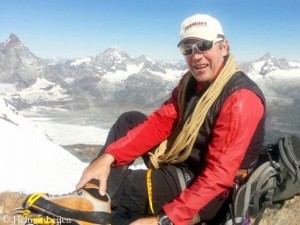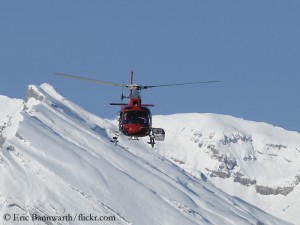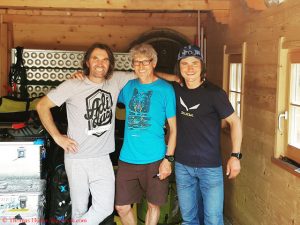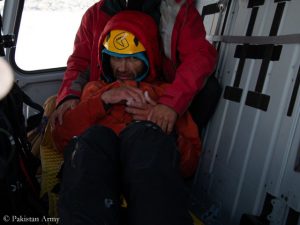“Recovery of dead is always sad – not only on the Matterhorn”
Even the first ascent of the Matterhorn 150 years ago ended in tragedy. Four team members died during the descent from the summit, when a rope ruptured. Since then, more than 500 climbers died on the “Horu”, as the locals call the Matterhorn – more than on any other mountain in Switzerland. Year after year there are between 2,500 and 3,000 summit attempts, also resulting in a lot of work for mountain rescuers. Helmut called “Helmi” Lerjen comes from a true mountain guide family. In the fourth generation, the Lerjens are guiding clients on mountains like the Matterhorn. Helmi, who is living with his wife and daughter in the small village of Täsch, close to Zermatt, has also been working for the Mountain Rescue Zermatt for almost 15 years. The Matterhorn, 150 years after the first ascent, from the perspective of a mountain rescuer:
Dani, all over the world the Matterhorn is a symbol for Switzerland. How do you see this mountain? Or in other words, what does it mean to you?
I have so far climbed the Matterhorn with clients 187 times. As technical director of the mountain guides of Zermatt, I am also responsible for the maintenance of the fixed ropes on the Matterhorn. Even in the 19th century, my great-great-grandfather Josef and my great-grandfather Alois guided guests on the Horu. In 1930, my grandfather Joseph Lerjen tried to first climb the North Face, but the attempt of his team failed. (One year later, the German brothers Franz and Toni Schmid were successful.) Along with his colleague Kaspar Mooser and their client Emile Blanchet, my grandfather climbed with strong determination on the North Face. They were only using wooden ice axes and crampons without front points (!). Unfortunately, they had to retreat because of rock fall and bad conditions on the wall. The rocks were covered with a thin layer of ice. They climbed for several hours. It is not known what height they reached exactly. If one of the three had slipped, it had meant the death of all. With luck, they escaped the North Face unharmed. With these stories of my forefathers I have a very personal relationship with the Matterhorn.
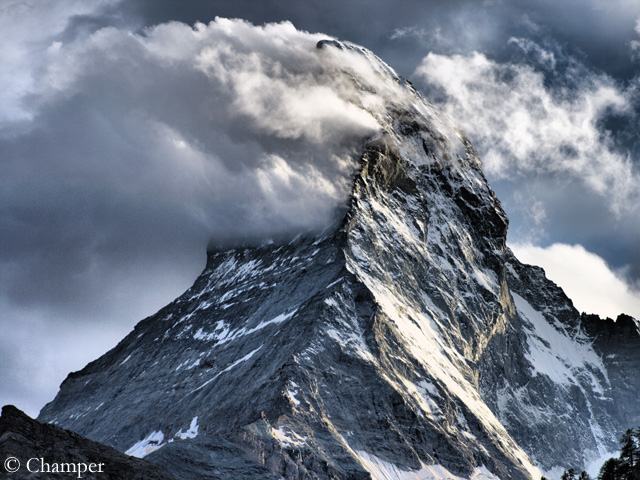
Even the first ascent of the Matterhorn ended with a disaster. Four climbers lost their lives. Do mountain rescuers still discuss this tragedy as an example of what can happen on the Matterhorn?
Every accident on the Matterhorn or other mountains is tragic. For us as very experienced mountain rescuers, it is best if we are able to save the lives of climbers. By contrast, it is always sad to recover dead. In this case you can actually no longer speak of rescue. It’s rather a work that we have to do.
As the technical director of the mountain guides in Zermatt, you are responsible for the fixed ropes on the Matterhorn. How secure is the normal route?
It is very difficult to find the right path on the Hörnli Ridge. The lower part is like a labyrinth. As soon as you stray from the correct route, you immediately find yourself in loose rock, which can then be really dangerous.
Every year about 80 rescue flights are made on the Matterhorn. More than 500 climbers have already died on the mountain. This makes the Matterhorn in absolute terms the most dangerous Swiss mountain. What are the most frequent causes of accidents?
The Matterhorn itself is not dangerous. It is the climber who makes it dangerous, for example by losing his way in the dark, then getting into loose rock and endangering other climbers by kicking off stones. As he gets lost, he is far too long on the mountain and becomes tired quickly. Then his concentration is rapidly decreasing.
Could many accidents be avoided and if yes how?
The Hörnli Ridge is one of the most difficult normal routes on four-thousanders in the Alps. Therefore, it is advisable to hire a mountain guide.
The Matterhorn is not a hiking mountain. Are many summit aspirants simply too careless?
I don’t believe that. It’s known that the Hörnli Ridge is one of the most challenging normal routes.
Too many climbers on a route almost inevitably lead to higher risk. Stones can be kicked off, there can be traffic jams on the route. Does a limitation of Matterhorn ascents make sense?
The construction of the new Hörnli Hut (the starting point on the summit day) has reduced the number of beds from 170 to 130. The ban of camping has led to 30 people less daily. So a total of about 70 people less will be on the way on Matterhorn per day. This ensures more safety.
If you could make the Matterhorn a present for the 150th anniversary of its first ascent, what would it be?
On 14 July 2015, exactly 150 years after the first ascent of the Matterhorn, no one will climb the mountain in honor of the first ascenders. I hope with all my heart that all mountaineers stick to it and that Horu has peace and quiet on this jubilee day.



